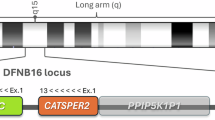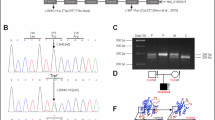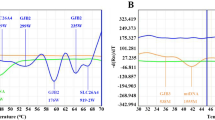Abstract
Genetic analysis of an inbred Pakistani family PKDF280, segregating prelingual severe to profound sensorineural hearing loss, provided evidence for a DFNB locus on human chromosome 9q34.3. Co-segregation of the deafness trait with marker D9SH159 was determined by a two-point linkage analysis (LOD score 9.43 at θ=0). Two additional large families, PKDF517 and PKDF741, co-segregate recessive deafness with markers linked to the same interval. Haplotype analyses of these three families refined the interval to 3.84 Mb defined by D9S1818 (centromeric) and D9SH6 (telomeric). This interval overlaps with the previously reported DFNB33 locus whose chromosomal map position has been recently revised and assigned to a new position on chromosome 10p11.23–q21.1. The nonsyndromic deafness locus on chromosome 9q segregating in family PKDF280 was designated DFNB79. We are currently screening the 113 candidate DFNB79 genes for mutations and have excluded CACNA1B, EDF1, PTGDS, EHMT1, QSOX2, NOTCH1, MIR126 and MIR602.
Similar content being viewed by others
Log in or create a free account to read this content
Gain free access to this article, as well as selected content from this journal and more on nature.com
or
References
Friedman TB, Griffith AJ : Human nonsyndromic sensorineural deafness. Annu Rev Genomics Hum Genet 2003; 4: 341–402.
Morton CC, Nance WE : Newborn hearing screening—a silent revolution. N Engl J Med 2006; 354: 2151–2164.
Medlej-Hashim M, Mustapha M, Chouery E et al: Non-syndromic recessive deafness in Jordan: mapping of a new locus to chromosome 9q34.3 and prevalence of DFNB1 mutations. Eur J Hum Genet 2002; 10: 391–394.
Belguith H, Masmoudi S, Medlej-Hashim M et al: Re-assigning the DFNB33 locus to chromosome 10p11.23-q21.1. Eur J Hum Genet 2009; 17: 122–124.
Grimberg J, Nawoschik S, Belluscio L, McKee R, Turck A, Eisenberg A : A simple and efficient non-organic procedure for the isolation of genomic DNA from blood. Nucleic Acids Res 1989; 17: 8390.
Schaffer AA : Faster linkage analysis computations for pedigrees with loops or unused alleles. Hum Hered 1996; 46: 226–235.
Kurima K, Peters LM, Yang Y et al: Dominant and recessive deafness caused by mutations of a novel gene, TMC1, required for cochlear hair-cell function. Nat Genet 2002; 30: 277–284.
Mburu P, Mustapha M, Varela A et al: Defects in whirlin, a PDZ domain molecule involved in stereocilia elongation, cause deafness in the whirler mouse and families with DFNB31. Nat Genet 2003; 34: 421–428.
Mustapha M, Chouery E, Chardenoux S et al: DFNB31, a recessive form of sensorineural hearing loss, maps to chromosome 9q32-34. Eur J Hum Genet 2002; 10: 210–212.
D'Adamo P, Donaudy F, D'Eustacchio A, Di Iorio E, Melchionda S, Gasparini P : A new locus (DFNA47) for autosomal dominant non-syndromic inherited hearing loss maps to 9p21-22 in a large Italian family. Eur J Hum Genet 2003; 11: 121–124.
Peters LM, Belyantseva IA, Lagziel A, Battey JF, Friedman TB, Morell RJ : Signatures from tissue-specific MPSS libraries identify transcripts preferentially expressed in the mouse inner ear. Genomics 2007; 89: 197–206.
Fettiplace R, Hackney CM : The sensory and motor roles of auditory hair cells. Nat Rev Neurosci 2006; 7: 19–29.
Street VA, McKee-Johnson JW, Fonseca RC, Tempel BL, Noben-Trauth K : Mutations in a plasma membrane Ca2+-ATPase gene cause deafness in deafwaddler mice. Nat Genet 1998; 19: 390–394.
Lanford PJ, Kelley MW : Notch signaling and cell fate determination in the vertebrate inner ear. Chapter 3 in development of the inner ear. in Kelley MW, Wu DK, Popper AN, Fay RR (eds): Springer Handbook of Auditory Research. Springer: New York, 2005. vol 26, pp 122–157.
Mencia A, Modamio-Hoybjor S, Redshaw N et al: Mutations in the seed region of human miR-96 are responsible for nonsyndromic progressive hearing loss. Nat Genet 2009; 41: 609–613.
Lewis MA, Quint E, Glazier AM et al: An ENU-induced mutation of miR-96 associated with progressive hearing loss in mice. Nat Genet 2009; 41: 614–618.
Acknowledgements
We are grateful to the participants of this study. We also thank Drs Melanie Barzik, Tamar Ben-Yosef, Byung Yoon Choi, and Dennis Drayna for suggestions regarding this article. We also thank Barbara Ploplis and Erich Boger for their technical assistance. This study was supported by the Higher Education Commission, Islamabad, Pakistan; EMRO/WHO-COMSTECH (RABGH 06–07_24), Ministry of Science and Technology (MoST), Islamabad, and intramural funds from the National Institute on Deafness and Other Communication Disorders, NIH (1 ZO1 DC000039-12) to TBF and (ZO1 DC000064) to AJG.
Author information
Authors and Affiliations
Corresponding author
Additional information
Electronic database information
Hereditary Hearing Loss Homepage: http://www.uia.ac.be/dnalab/hhh/
Primer3 Web-Based Server: http://frodo.wi.mit.edu/cgi-bin/primer3/primer3_www.cgi
UCSC Genome Bioinformatics: http://genome.ucsc.edu/
Morton Fetal Cochlea cDNA Library: http://www.brighamandwomens.org/bwh_hearing/InnerEarcDNAArrays.aspx
NEIBank (select cochlear library): http://neiblast.nei.nih.gov/
Rights and permissions
About this article
Cite this article
Khan, S., Riazuddin, S., Shahzad, M. et al. DFNB79: reincarnation of a nonsyndromic deafness locus on chromosome 9q34.3. Eur J Hum Genet 18, 125–129 (2010). https://doi.org/10.1038/ejhg.2009.121
Received:
Revised:
Accepted:
Published:
Issue date:
DOI: https://doi.org/10.1038/ejhg.2009.121
Keywords
This article is cited by
-
Identification of autosomal recessive nonsyndromic hearing impairment genes through the study of consanguineous and non-consanguineous families: past, present, and future
Human Genetics (2022)
-
A combined genome-wide association and molecular study of age-related hearing loss in H. sapiens
BMC Medicine (2021)
-
Tprn is essential for the integrity of stereociliary rootlet in cochlear hair cells in mice
Frontiers of Medicine (2019)
-
Haplotype analysis of DFNB8/10 locus reveals contribution of TMPRSS3 mutations in Pakistani deaf population
Genes & Genomics (2014)



